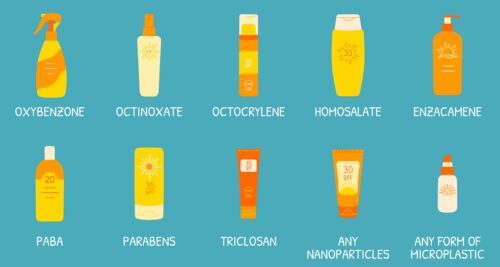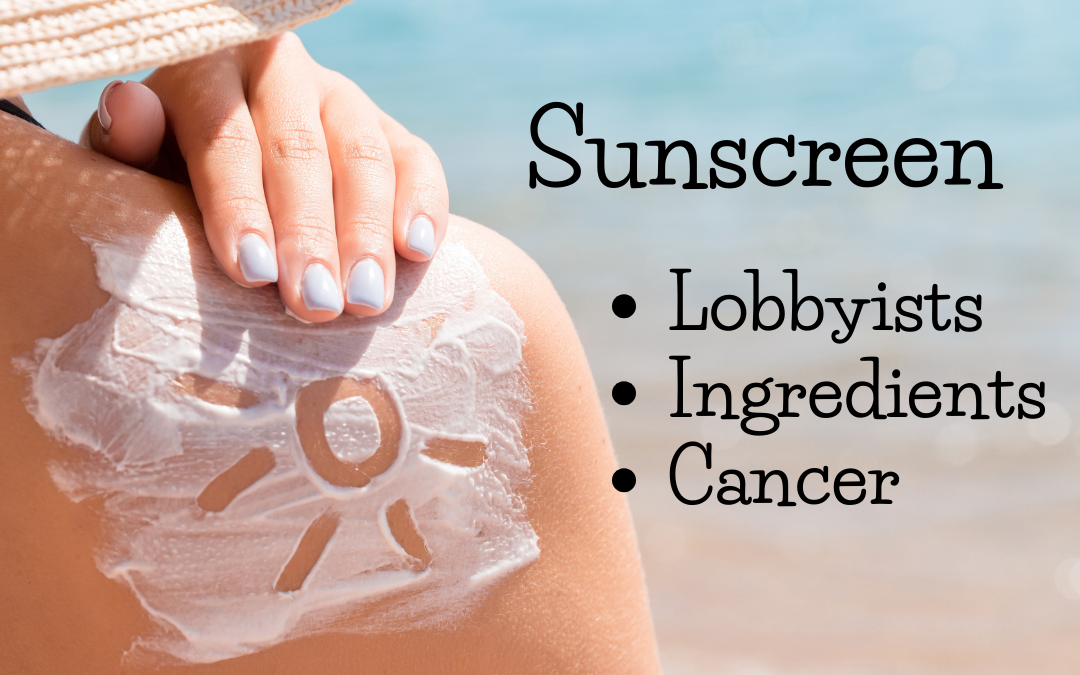As we slather on sunscreen to protect our skin from the sun’s rays, many of us assume we’re safeguarding our health. However, behind the allure of sun protection lies a complex web of corporate interests that have resulted in regulatory capture through lobbyists’ involvement. While sunscreen remains a staple in the skincare routine of many, recent revelations have shed light on the less savory aspects of the industry such as the presence of potentially harmful ingredients and their potential cancerous after-effects. Join us to uncover the hidden truth behind sunscreen: lobbyists’ involvement, sunscreen harmful ingredients, and skin cancer rates.
Sunscreen Use Over The Years
One of the truths behind sunscreen is that it has been used for thousands of years in various forms. Different cultures and ancient civilizations like the Greeks, Egyptians, Romans, Chinese, and Native Americans have protected their skin through different formulations with plant extracts, minerals, and other natural ingredients with sun-blocking properties to shield themselves. Let’s take a look:
- Ancient Egyptians: They used extracts from rice bran, jasmine, and lupine plants to create sunscreen-like ointments. Additionally, they used a variety of oils, such as sesame oil, to protect their skin from the sun.
- Ancient Greeks and Romans: Olive oil was commonly used by these cultures not only as a food staple but also as a skincare product. It was believed to have moisturizing properties and provided some protection against the sun.
- Ancient Indians: In Ayurvedic medicine, which originated in ancient India, natural ingredients like aloe vera, neem oil, and turmeric are used for skin care. These substances were believed to have cooling and protective properties against the sun.
- Ancient Chinese: Rice bran paste was used as a sunscreen by ancient Chinese civilizations. They also used various herbal concoctions containing ingredients like licorice root and extracts from plants like Job’s tears (Coix lacryma-jobi) for skin protection.
- Native Americans: Indigenous peoples of North and South America used natural substances such as clay and plant extracts to protect their skin from the sun. Some tribes used mixtures of plant oils and extracts like jojoba, shea butter, and cactus extracts for skincare.
These ancient cultures relied on their knowledge of local plants and natural ingredients to develop sun protection methods suitable for their environments. While these concoctions were not like the modern formulations, they offered some defense against the sun’s rays and helped to keep the skin healthy.
Modern Sunscreen
Modern sunscreen with its widespread commercial availability, began to emerge in the early 20th century. One of the earliest commercial sunscreens was introduced by chemist Franz Greiter in 1938. He developed the first sun protection factor (SPF) rating system to measure a sunscreen’s effectiveness. Greiter’s creation, “Glacier Cream,” later evolved into the brand known as Piz Buin.
In the United States, the modern sunscreen era began in the 1940s with the development of products like Coppertone. Sunscreen usage began to gain traction in the 1970s and 1980s as public awareness campaigns started to convey a message about the harmful effects of UV radiation on the skin. Sunscreens offered protection against UVB rays during this time, with formulations often featuring low SPF ratings.
The 1990s saw significant advancements in sunscreen technology, including the introduction of broad-spectrum sunscreens that offered protection against both UVA and UVB rays. Campaigns by health organizations and skincare companies further promoted sunscreen use as a crucial component of sun safety during outdoor activities.
In the 2000s and beyond, there has been a continued emphasis on sunscreen as a preventative tool against skin cancer. Current formulations are now water and sweat-resistant and offer a cosmetic appeal. Additionally, applying sunscreen has been encouraged year-round, not just during the summer months.
Lobbyists Involvement
The truth behind sunscreen is that sunscreen use recommendations have evolved due to diverse influences. Let’s explore how lobbying efforts have impacted sunscreen campaigns and regulations.

Lobbyists represent companies in the cosmetics, pharmaceutical, and skincare industries. They advocate for policies favorable to the production, sale, and use of sunscreen products. Their primary goal is to influence government regulations, legislation, and public opinion to support the interests of sunscreen manufacturers and sellers.
Additionally, they engage with government regulatory agencies, such as the Food and Drug Administration (FDA) in the United States, to provide input on proposed regulations and seek regulatory approval for sunscreen products. Once lobbying efforts are successful at different junctions, health campaigns hit the mainstream media. These health initiatives involve the government, health agencies, dermatologist groups, and other stakeholders, which are instrumental in promoting sunscreen use to the public.
- In the late 1970s and early 1980s, lobbyists came into the picture and started promoting sunscreen use. They highlighted the harmful effects of UV radiation and associated it with skin cancer.
- Lobbying efforts by various stakeholders intensified during the 1990s to raise awareness about the importance of sun protection and to advocate for policies supporting the use of sunscreen. This is when the sunscreen industry started to see significant growth, with various companies competing to produce more effective and appealing products.
- In the early 2000s, concerns started to arise regarding the environmental impact of some sunscreen ingredients on coral reefs.
- In 2018, Hawaii became the first state to pass legislation banning the sale of sunscreens containing oxybenzone and octinoxate.
- In 2020, lobbying efforts by sunscreen manufacturers intensified to influence policymakers, environmental organizations, and the public discourse on the use of chemical versus mineral sunscreens and their impact.
Now that you understand that public health campaigns involve the influence of lobbyists who have corporate profit in mind, you should also know that U.S. sunscreen manufacturers are legally allowed to use chemicals at concentrations up far above the European Commission’s recommendations. This may be because regulatory agencies, such as the FDA and CDC, have been captured by corporations, resulting in sunscreen products containing ingredients that are not safe for consumers.
Harmful Sunscreen Ingredients
One of the implications of combining lobbying efforts with corrupt regulatory agencies on public health is unsafe products. Another truth behind sunscreen is that most sunscreen ingredients are not healthy even though health campaigns recommend using sunscreen to protect the skin from UV radiation.

Here are some of the problems associated with sunscreens and harmful sunscreen ingredients:
Cancer-Causing Ingredients
Health campaigns promoting the need for sunscreen use claim that sunscreen is needed to protect us against cancer. A shocking truth behind sunscreens is that many sunscreen products have numerous cancer-causing compounds. These compounds, benzene being one of those, have also been detected in sunburn-relief gels.
Nanoparticles (NPs)
Other damaging sunscreen ingredients are nanoparticles. NPs can get absorbed by the skin, stay in the skin, and even cross the blood–brain barrier since they have been found in the liver, lungs, spleen, and brain. Continuous exposure to NPs could lead to “excessive generation of ROS and reactive nitrogen species (RNS), inflammation, fibrosis, and pulmonary damage, oxidative stress at the cellular level resulting in chemical and structural modifications of macromolecules. In extreme cases, oxidative DNA damage occurs that results in cytotoxicity or in mutations that can cause cancer.”
Chemical Ingredients
Many commercial sunscreens contain chemicals (avobenzone, cinoxate, dioxybenzone, ensulizole, homosalate, meradimate, octinoxate, octisalate, octocrylene, oxybenzone, padimate O, and sulisobenzone) that can’t be recognized as “safe” by the FDA.
Vitamin D Deficiency
One of the factors increasing the high rates of vitamin D deficiency is the use of sunscreen. Using sunscreen blocks UVB radiation, which is necessary for the skin to produce vitamin D. Another truth behind sunscreens is that their prolonged and consistent use, especially with high SPF levels, reduces vitamin D synthesis in the skin. In turn, vitamin D deficiency increases your chances of getting cancer.
Endocrine-Disrupting Ingredients
Research shows that other ingredients (homosalate, avobenzone, octinoxate, and oxybenzone) present in sunscreens have raised concerns about their potential hormone-disrupting effects. These can be absorbed through the skin, enter the bloodstream, and be detected on the skin, bloodstream, breast milk, and urine weeks after being used, and affect reproductive and thyroid hormone balance.
Skin Irritation and Allergic Reactions
Certain ingredients in sunscreen, such as fragrances and preservatives, can cause skin irritation and allergic reactions in some individuals. This can manifest as redness, itching, or a rash. People with sensitive skin should be cautious and opt for sunscreens labeled as hypoallergenic or formulated for sensitive skin.
Potential Environmental Impact
Studies show that chemicals in sunscreen can have harmful effects on marine life and coral reefs. These chemicals have been shown to contribute to coral bleaching and interfere with the growth and development of coral organisms. Other compounds tend to bioaccumulate in aquatic animals, such as corals, algae, arthropods, mollusks, echinoderms, and marine vertebrates.
Lack of Effectiveness
Besides the poor safety profiles of most sunscreens, their effectiveness also comes into question. A systematic review of the literature related to effectiveness shows that sunscreen use can’t confirm the expected protective benefits of sunscreen against skin cancer and photoaging in the general population.
Skin Cancer Rates
With mounting concerns over skin cancer emphasized through health campaigns and the use of sunscreen, it’s important to look into skin cancer rates over the years. According to the National Institutes of Health, cutaneous melanoma is the fifth most common cancer in the United States and the deadliest type of skin cancer (malignant melanoma) has a mortality rate of 1.1%.
Here is the data related to the incidence of skin cancer:
- The incidence of malignant melanoma (an invasive form of melanoma where cancerous cells have penetrated deeper into the skin layers and may have spread to other parts of the body) went from 10.5 per 100,000 in 1980 to 25.38 per 100,000 in 2017.
- The incidence of in situ melanoma (stage 0 melanoma where cancer cells are only found in the outer layer of the skin) has increased even more. It went from <1 per 100,000 in 1973 to 14 per 100,000 in 2006.
The incidences of skin cancer have increased significantly over the past several decades according to the government’s numbers. The rates of skin cancer in the 1960s were much lower compared to contemporary rates. How is this possible when most people have followed the health institutions and public campaigns’ recommendations?
More people than ever have decreased their sun exposure and have increased their sunscreen use, which may be the problem. We now have research showing that typical sunscreens are not only ineffective in protecting against skin cancer and photoaging but are even harmful due to their toxic ingredients.
You are better off using natural products that don’t contain chemicals. Nature has many compounds and goods with sun-protective properties such as coconut oil, shea butter, eucalyptus and lavender essential oils, and zinc oxide (non-nano). If you are going to spend several hours outdoors and want to apply sunscreen, choose safer sunscreens (Stream 2 Sea, Babo Botanicals, Attitude – researched and certified by Environmental Working Group) and follow these healthy sunbathing tips.
Conclusion
The intricate relationship between sunscreen lobbyists, corporations, and regulatory agencies has implications for public health. It’s imperative to understand the truth behind sunscreen and the full picture surrounding the products we trust to protect us. After uncovering some commonly used sunscreen ingredients and their potential risks to both humans and the environment, we can recognize some of the reasons for the rising skin cancer rates and start making more informed choices about our sun protection practices.
To a Fitter Healthier You,
The Fitness Wellness Mentor



